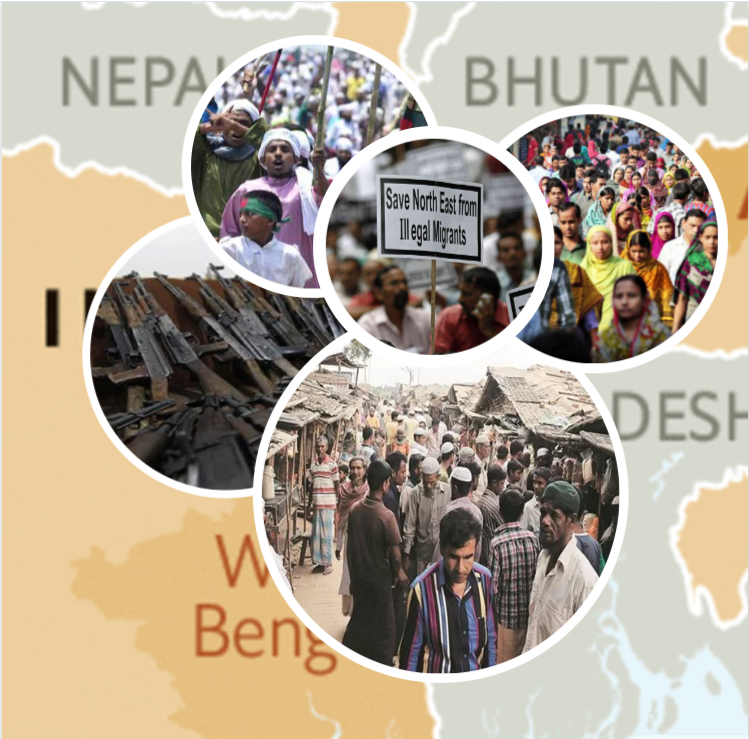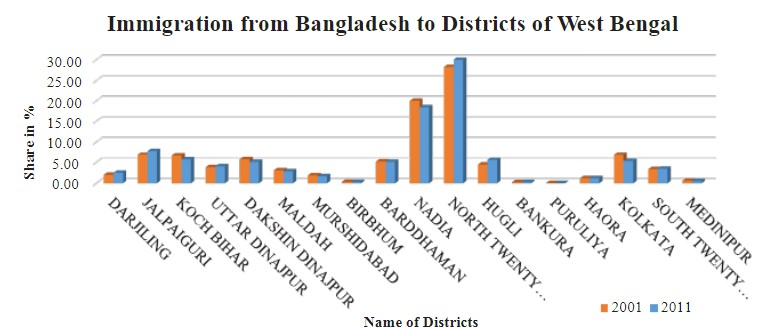
- The shifting population in West Bengal districts have sparked worries about community harmony and blending, with fear that different cultures and faiths can cause friction within local groups.
- This population change puts pressure on current resources and facilities leading to problems like crowding, joblessness, and competition for resources.
- The Indo-Bangladesh border is a smuggler’s paradise with the smuggling of illegal weapons posing a significant threat to India’s national security.
On 21 July During Trinamool’s Saheed Dibas West Bengal Chief Minister Mamata Banerjee made an arguable remark regarding her willingness to welcome Bangladeshi citizens seeking assistance within the state has generated significant concerns related to national security and India’s foreign policy at the same time invited serious criticism across the political spectrum. This event again brings out the importance of studying the developments regarding illegal migration to districts in the state of West Bengal
The problem of the increasing inflow of illegal migrants from Bangladesh to West Bengal has been disturbing for years now. The presence of a porous border between these two countries has facilitated easier movement of people without proper legal immigration documents thereby resulting in significant demographic changes in the population of neighbouring districts. Besides, this massive flow-in and blend-in with the natives has not only posed security threats but also a deliberation on socio-economic effects on the area.
West Bengal state shares a 2217-km lengthy permeable borderline with Bangladesh thus making it the most preferred pathway for those who want to cross over without utilizing legal channels. Of late, there have been rising numbers of undocumented immigrants migrating to West Bengal looking for economic prosperity and a better life. This is however an uncontrolled move that significantly restructures the demography of many districts.
One main worry about illegal migration is its effect on the state’s security system. Where residents make their way into the region without proper clearance papers, authorities find it hard to monitor and trace them down. This sets the stage for unlawful acts like smuggling human trafficking, and possible terrorist operations.
Also, the shifting population in West Bengal districts such as Nadia, North 24 Parganas, Murshidabad etc have sparked worries about community harmony and blending. The quick inflow of people from other countries with different cultures and faiths can cause friction within local groups. This population change can also put pressure on current resources and facilities leading to problems like crowding, joblessness, and competition for resources.

Security Threat to WB and India
On top of the social and economic effects, we can’t ignore the safety and strategic challenges illegal migration brings. The porous border between Bangladesh and West Bengal makes it hard for officials to watch and manage the movement of people across the border. This not only hinders efforts to stop illegal migration but also creates a security gap that bad actors can exploit.
There have been a few events that have highlighted the grave security threats in the state. The emergence of fundamental radical ideologies in West Bengal, attributed to the influx of illegal Bangladeshis, is a significant security threat to the state and country. The Bardhhaman blast(2014) planned by Jamat-ul-Mujaheddin (JMB) of Bangladesh was one of the instances where the illegal immigrants posed a threat to the security of India, West Bengal in particular. Then various arrests have taken place where the security authorities busted numerous terror links and taken custody of the involved and the accused in such cases.
For instance, a recent news report stated that the Special Task Force (STF) of the West Bengal police arrested a second-year Computer Science student from Panagarh in the state’s Purba Bardhhaman district, who had alleged links to a Bangladesh-based terror outfit Ansar Al Islam, which is affiliated to Al Qaida. In February 2022, CID arrested a Bangladeshi wanted terrorist from North 24 Parganas district of West Bengal.
Smuggler’s Paradise!
The Indo-Bangladesh border has emerged as a smuggler’s paradise. Illegal migration has added physical support to the process. The smuggling of illegal weapons poses a significant threat to India’s national security as indicated by a series of news reports. Due to the lack of roads and longer distances between BOPs, border patrolling is particularly challenging. As a result, militant organisations abuse certain sections of the border to bring weapons and drugs and pass them into Bangladesh.
To tackle the problem of growing illegal migration from Bangladesh to West Bengal, we need a varied approach. First, India needs better border security measures to stop illegal crossings and improve the entry of people through legal ways. This can be done by staffing up more border patrol agents, employing technology that can be in the form of drones and surveillance cameras, and putting up other checkpoints around the border area.
Second, there is a general call for the cooperation of authorities in both India and Bangladesh to properly look at the issues leading to the act of illegitimate migration. As part of these measures, the fight against poverty, changes in economic status, and optimization of the management of borders are paramount. There is also an added advantage whereby joint patrols as well as sharing of intelligence can help in containing unlawful acts along the border.
Thus, it becomes necessary to increase focus on the factors that would enhance the development of districts of West Bengal for seeking social and economic troubles affected by illegal migration. This consists of Infrastructure improvement, employment generation as well as training and development to ensure means of living for the citizens as well as the migrants.
Finally, addressing the issue of unauthorized migration from Bangladesh to West Bengal is a complex challenge that requires a comprehensive and interdependent approach. Strengthening border security, addressing the root causes of illegal migration, and fostering development in affected regions can significantly mitigate the problem. Therefore, it is essential for both the Indian and Bangladeshi administrations to work together to resolve this issue and ensure the safety and well-being of their populations.
(Pritam is pursuing an MA in Politics and International Relations at the Department of Politics and International Studies, Pondicherry University. His Area of interest includes India’s Foreign Policy, Defence and Security Studies, Intelligence and Strategic Warfare. Views and opinions expressed are the author’s own)
Pritam Sarbabidya is a postgraduate in Politics and International Relations from Pondicherry University. He writes on India’s foreign policy, security and strategic affairs, with bylines in Samvada World, Modern Diplomacy, Firstpost, The Dialectics and other platforms. He tweets at @Psarbabidya. Views expressed are the author’s own.
